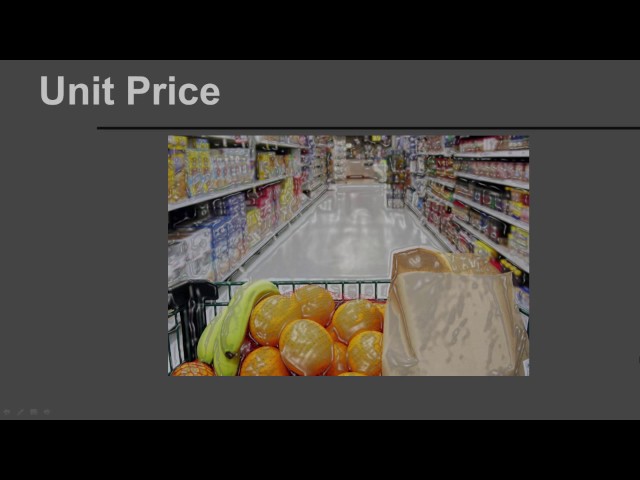Mastering the Art of Smart Shopping: A Comprehensive Guide on How to Calculate and Compare Unit Prices at the Store

Introduction:
Navigating the aisles of a grocery store or any retail outlet involves more than just picking items off the shelves. To make informed and budget-conscious decisions, understanding how to calculate and compare unit prices is a crucial skill. Unit prices allow consumers to evaluate the true cost of products, ensuring they get the best value for their money. In this extensive guide, we will delve into the intricacies of unit pricing, providing step-by-step instructions on how to calculate and compare unit prices at the store.
Section 1: Decoding Unit Prices
1.1 Definition of Unit Price:
- Unit price, often displayed on store shelves, represents the cost per standard unit of measurement (e.g., per ounce, per pound, per liter). It enables shoppers to compare the cost efficiency of different product sizes and brands, ensuring they make economically sound choices.
1.2 Significance of Unit Prices:
- Understanding unit prices empowers consumers to make cost-effective decisions. By comparing the price per unit, shoppers can identify the most economical option and avoid being swayed by packaging or promotional tactics. This skill is particularly valuable for budget-conscious individuals and those looking to optimize their grocery spending.
Section 2: Calculating Unit Prices
2.1 Basic Formula for Unit Price:
- The unit price is calculated by dividing the total price of the item by its quantity. The formula is expressed as follows:
\text{Unit Price} = \frac{\text{Total Price}}{\text{Quantity}}
2.2 Example Calculation:
- Suppose a product has a total price of $5.00 and a quantity of 10 ounces. The unit price would be calculated as:
\text{Unit Price} = \frac{5.00}{10} = 0.50 \, \text{per ounce}
- This indicates that the cost per ounce is $0.50.
Section 3: Comparing Unit Prices
3.1 Standardizing Measurements:
- Before comparing unit prices, ensure that the measurements are standardized. For example, if one product is priced per ounce and another per pound, convert both to the same unit for accurate comparison.
3.2 Comparing Similar Items:
- When comparing unit prices, focus on similar products or items with equivalent qualities. For instance, if evaluating two brands of cereal, compare the unit prices of the same-sized packages to make an informed decision.
Section 4: Strategies for Smart Shopping
4.1 Bulk Buying and Savings:
- Analyze unit prices to determine if buying in bulk provides cost savings. Often, larger quantities have lower unit prices, making bulk purchases economical over the long term.
4.2 Private Label vs. Brand Name:
- Compare unit prices between private label (store brands) and brand-name products. Private labels may offer a more budget-friendly option without compromising quality.
Section 5: Tips for Efficient Unit Price Comparison
5.1 Understand Unit Measurements:
- Familiarize yourself with common unit measurements (ounce, pound, liter, etc.) to ensure accurate calculations and comparisons. Pay attention to variations, such as fluid ounces versus dry ounces.
5.2 Check for Discounts and Promotions:
- Be aware of discounts, promotions, or bundled deals. Sometimes, buying a larger quantity on sale can result in a lower unit price, providing additional savings.
Section 6: Utilizing Technology for Unit Price Comparison
6.1 Mobile Apps and Online Tools:
- Leverage technology to streamline unit price comparisons. Numerous mobile apps and online tools allow shoppers to input product details and receive instant unit price calculations, simplifying the decision-making process.
6.2 Price Comparison Websites:
- Explore price comparison websites that aggregate unit prices for various products across multiple retailers. These platforms provide a comprehensive overview, helping consumers identify the most cost-effective options.
Section 7: Considerations for Perishable Items
7.1 Evaluate Shelf Life:
- When comparing unit prices for perishable items, consider the shelf life. While buying in bulk may offer cost savings, it’s essential to assess whether the quantity aligns with your consumption patterns to avoid waste.
7.2 Factor in Storage Capacity:
- Assess your storage capacity before opting for bulk purchases. While the unit price may be lower, it’s essential to ensure you have adequate space to store the items without compromising their quality.
Conclusion: Empowering Consumers with Informed Choices
Mastering the art of calculating and comparing unit prices transforms the shopping experience from a routine task to a strategic and empowering endeavor. By understanding the significance of unit prices, learning how to calculate them, and utilizing effective comparison strategies, consumers can make informed decisions that align with their budgetary goals. Armed with these skills, shoppers contribute to a more economically conscious and resourceful community, emphasizing the importance of value-driven choices in every trip to the store.







